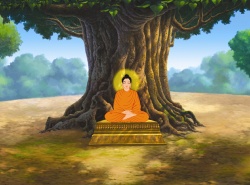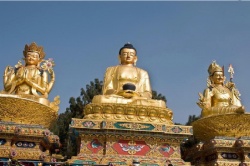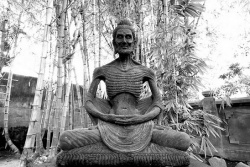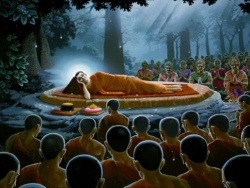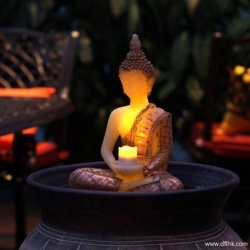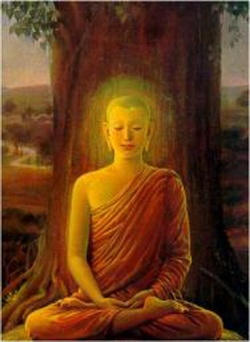Āryasatyāni
āryasatyāni; ariya-saccāni; Noble Truths. The entire teachings of Buddhism are contained in what are known as Noble Truths. These are four in number:
(1) the truth of suffering,
(2) the truth of the origin of suffering,
(3) the truth of the cessation of suffering, and
(4) the truth of the Eightfold Path leading to the cessation of suffering.
These truths are known as āryasatyāni.
All forms of existence are subject to suffering. Craving is the cause of suffering. Extinction of craving leads to the extinction of suffering including rebirth. The Eightfold Path is the means for achieving the goal of cessation of suffering.
The etymological meaning of the word duḥkha is that which is difficult (dus) to endure for the organs (kha). Kha also means empty. Thus, duḥkha means the emptiness of the world which is despicable (dus).
The first and the second Truths are mundane and the third is supramundane. An aspirant should understand the first Truth; he should give up the second, namely, craving, the origin of suffering; he should realise the third, that is, the truth of cessation of suffering; and should cultivate the fourth, that is, the Eightfold Path.
The teaching of the Four Noble Truths does not indicate that the nature of Buddhism is pessimistic. On the other hand it is meant for relieving mankind from sorrow. Just as, in order to treat sickness, a physician has to make correct diagnosis to find out the cause of the sickness, in the same way the Buddha searched for the cause of suffering and found the way for its removal. Hence he is described as the great physician who cures all pains and sufferings. It is through relationship of the cause and effect that he could think of the cessation of suffering.
(1) The Truth of Suffering (duḥkha-satya) dukkha-sacca.
All life is suffering. All are subject to birth (jāti), old age (jarā), disease (vyādhi), and death (maraṇa). Nobody can escape from these sufferings. There is suffering due to separation from what we like, contact with what we dislike, unfulfilled aims, and clinging to the five aggregates (skandha-s).
That suffering which is due to injury or a bodily sensation is physical suffering. That which is due to separation from possessions is mental suffering. All phenomena of existence are subject to change. The impermanent nature of the states of existence is itself a cause of suffering. This kind is known as phenomenological suffering. Suffering is also due to alteration, that is, an experience may appear to be pleasant in the beginning but may end in sorrow.
The Buddha said, "This is, O Bhikkhu-s, the Noble Truth of Suffering; Birth is suffering; ageing is suffering; sickness is suffering; death is suffering; sorrow and lamentation, pain, grief and despair are suffering; association with the unpleasant condition is suffering; separation from the beloved one or pleasant condition is suffering; not to get what one wants is suffering, in brief, the five aggregates of attachment are suffering."
(2) The Truth of the Origin of Suffering (duḥkha-samudaya satya) dukkha-samudaya sacca
In the Dhammacakkappavattana Sutta the Buddha says, "The cause of suffering is craving that finds pleasure now here, now there." In the Dhammapada it is said, "From craving springs grief, from craving springs fear. He who is free from craving has neither grief nor fear." Craving is compared to a river. It is the cause of rebirth and evils in life. The once-returner (sakṛdāgāmī) attenuates the gross forms of craving, the non-returner (anāgāmī) eradicates them and the Arhat is free from even the subtle forms of craving.
Craving is of three kinds -- craving for sensual pleasures, for existence and for non-existence. The craving for sensuous desires arises from the objects of senses. Gratification of sensual desires gives happiness to the seeker. However it is a fleeting experience and even its recollection is temporary. Craving for existence is the desire for the superior realms of forms, and craving for non-existence is attachment for the formless realms.
The Buddha said, "This is, O Bhikkhu-s, the Noble Truth of the Origin of Suffering: it is this craving which produces rebirth, bound up with pleasure and greed. It finds fresh delight now here and now there."
(3) The Truth of Cessation of Suffering (duḥkha-nirodha satya) dukkha nirodha sacca]
The Dhammacakkappavattana Sutta defines this truth as eradication of all forms of craving. Extinction of suffering presupposes extinction of greed, of anger and of ignorance. This state of extinction is known as nirvāṇa. It can be experienced after renouncing attachment to the external world. The Noble Eightfold Path is the way to realise the truth of the extinction of suffering.
The Buddha said, "This is, O Bhikkhu-s, the Noble Truth of the Cessation of Suffering. It is complete cessation of craving, giving it up, renouncing it, release from it, detachment from it."
(4) The Truth of the Eightfold Path leading to the cessation of suffering (mārga satya) magga sacca dukkha-nirodhagāminī paṭipadā-sacca
The Theravāda school lays emphasis on the Noble Eightfold Path (ārya aṣṭāṅgika mārga) ariya aṭṭhaṅgika magga as the basic teaching whereas the Mahāyāna tradition emphasises the perfections -- pāramitā-s. The Buddha says, "What, O monks, is the Noble Truth of the path leading to the extinction of suffering? It is the Noble Eightfold Path that leads to the extinction of suffering."
The path consists of the following factors
(1) right view (samyag dṛṣṭi) sammā diṭṭhi,
(2) right resolution (samyak saṃkalpa) sammā saṅkappa,
(3) right speech (samyak vācā) sammā vācā,
(4) right action (samyak karmānta) sammā kammanta,
(5) right livelihood (samyag ājīva) sammā ājīva,
(6) right effort (samyag vyāyāma) sammā vāyāmā,
(7) right mindfulness (samyak smṛti) sammā sati,
(8) right concentration (samyak samādhi) sammā samādhi.
These factors are classified under three heads, namely, śīla, that is, morality; prajñā, that is, wisdom, and samādhi, that is, concentration. Right speech, action and livelihood constitute śīla. Right view and resolution constitute prajñā. Right effort, mindfulness and concentration constitute samādhi.
Right View
It is the understanding of the Four Noble Truths and the formula of the Dependent Origination. It comprises penetrative insight into the reality, that is, the emptiness.
The Buddha says, "What, O Bhikkhu-s, is Right View? To understand suffering, to understand the origination of suffering, to understand extinction of suffering, to understand the Path leading to the extinction of suffering; this is called Right View."
Right Resolution
It implies pure mind which is free from desire, ill will, hatred and cruelty. Instead it is endowed with harmlessness, compassion, benevolence and loving kindness. Actions are latent in thoughts. Evil thoughts defile an individual, and good thoughts elevate him. Thus, one should cherish right thoughts. Right resolution has twofold function, namely, to eliminate wrong ideas and to harbour good thoughts which, in due course, would lead the aspirant to nirvāṇa.
The Buddha says, "What, O Bhikkhu-s, is Right Resolution? Thoughts free from sensuous desire [nekkhama saṅkappa], thoughts free from ill will [abyāpāda saṅkappa], thoughts free from cruelty [avihimsā saṅkappa]: this is called Right Resolution".
Right Speech
It is the expression of right thoughts. In other words, right thoughts lead to right speech. Right speech means refraining from lying, slander, harsh words, and frivolous talk. The speech should be true, sweet, agreeable and beneficial to others.
The Buddha says, "What, O Bhikkhu-s, is Right Speech? It is avoidance of telling lies, avoidance of slandering, avoidance of hateful abusive language, avoidance of frivolous talk or useless chat. Bhikkhu-s, avoidance of these four evil speeches is called Right Speech."
Right Action
It means abstinence from killing, from stealing and from unlawful sexual contacts. These three evils are rooted in craving, ignorance and anger. Removal of these unwholesome roots eliminates germs of evil actions.
The Buddha says, "What, O Bhikkhu-s, is Right Action? It is the avoidance of killing, avoidance of stealing, and avoidance of sexual misconduct or misuse of the senses. O Bhikkhu-s, avoidance of these three physical evils is called Right Action."
Right Livelihood
A lay disciple should not earn his livelihood from the following kinds of trade, namely, trading in arms, in human-beings, in flesh, in intoxicating drinks and poison.
The Buddha says, "What, O Bhikkhu-s, is Right Livelihood? The noble disciple avoiding a wrong way of living, getting his means of living by a right way. This is called Right Livelihood."
Right Effort
Right Effort is fourfold, namely,
to prevent the arising of evil that is not yet arisen,
to discard the evil that has already arisen,
to develop the arising of good,
to promote the good that has already arisen, to increase it and to bring it to perfection.
The Buddha says, "What, O Bhikkhu-s, is Right Effort? Here in this teaching, O Bhikkhu-s, a Bhikkhu rouses his mind to avoid evil unwholesome things not yet arisen, to overcome evil unwholesome things already arisen, to arouse wholesome things not yet arisen, to maintain wholesome things already arisen and not to let them disappear, but to bring them to growth, to maturity and to the full perfection of development. And he makes effort, puts forth his energy, exerts his mind and strives. This is called Right Effort."
Right Mindfulness
It is to contemplate on body, feelings, thoughts and mind-objects after doing away with covetousness and grief. It eradicates wrong notions regarding desirability of happiness, permanence and soul.
The Buddha says, "What, O Bhikkhu-s, is Right Mindfulness? Here, in this teaching, a bhikkhu dwells contemplating the body (material qualities) in the body, ardently, clearly comprehending, and mindfully removing covetousness and grief in the world (of corporeality); he dwells contemplating the feeling in the feelings, he dwells contemplating the consciousness in the consciousness; he dwells contemplating the mental objects dhamma in the mental objects dhamma, ardently, clearly comprehending, and mindful, removing covetousness and grief in the world (of five aggregates). This is called Right Mindfulness."
Right Concentration
It is the one-pointedness of mind. It quietens the mind and makes it clear like a mirror. A concentrated mind perceives the true nature of things. The aspirant free from sensual objects and evils enters the first, the second, the third, and the fourth, dhyāna, that is, absorption.
The Buddha says, "What, O Bhikkhu-s, is Right Concentration? Here, in this teaching, the Bhikkhu, being detached from all sensual objects, detached from other unwholesome things, enters into the first stage of absorption jhāna, which is accompanied by thought conception vitakka and discursive thinking vicāra, is filled with rapture pīti and joy sukha, born of detachment from evil thoughts.
After subsiding of thought conception and discursive thinking, and by gaining inner tranquillity and one-pointedness of the mind, the aspirant enters into a stage of the second absorption, which is born of concentration and filled with rapture and joy.
After fading away of rapture, the aspirant dwells in equanimity, attentiveness and is clearly conscious; he experiences in his person that feeling of which the noble ones say 'Happy is the man of equanimity and one-pointedness of the mind' -- thus he enters the third absorption.
After giving up of the physical pleasure and pain, and through the disappearance of mental happiness and grief, the aspirant enters into a state beyond pleasure and pain, into the fourth absorption, which is purified by equanimity upekkhā and one-pointedness. This is Right Concentration."
The Buddha says, "O monks, it is through not understanding, not penetrating Four Noble Truths that we have run so long, wandered so long in this round of existence (saṃsāra) both you and I. But when these Four Noble Truths, O monks, are understood and penetrated, rooted out is the craving for existence (bhava-taṇhā), destroyed is that which leads to renewed becoming, and there is no more coming to be."
Page: Dīgha Nikāya. Mahāli, Mahāparinibbāna, Mahāsatipaṭṭhāna, Mahāsīhanāda. Flower. VIII. 276-281. The Madhyamakaśāstram. XXIV. 40. Majjhima Nikāya. Bhayabherava, Cūḷadukkhakkhandha, Cūḷasaccaka, Cūḷavedalla, Kinti, Mahāhatthipadopama, Mahāsaccaka, Sallekha, Sāmagāma, Sammādiṭṭhi. Saṃyutta Nikāya. Avijjā,Dhammacakkappavattana, Dukkhatā, Jāṇussoṇi, Kimatthiya, Kumbha, Sāriputta, Sīlasampadādi, Upaḍḍha, Vibhaṅga, Yonisomanasikāra.
